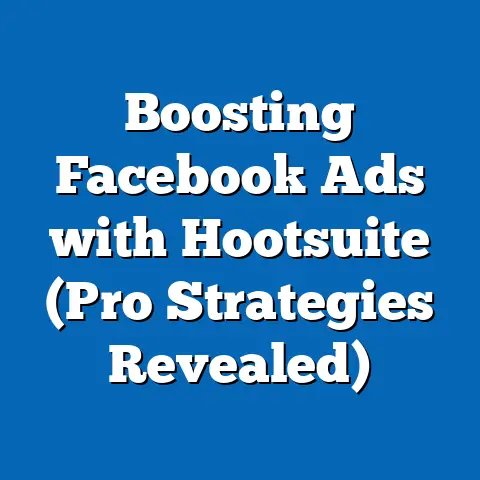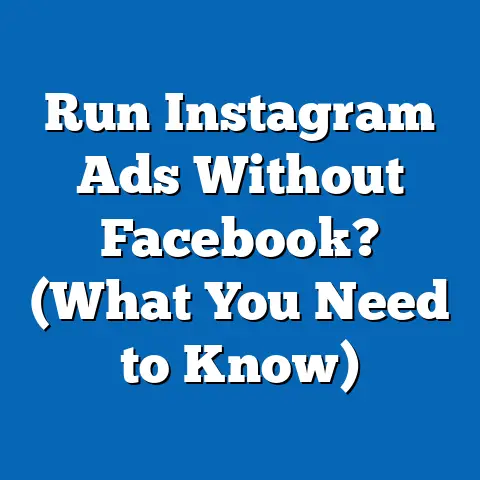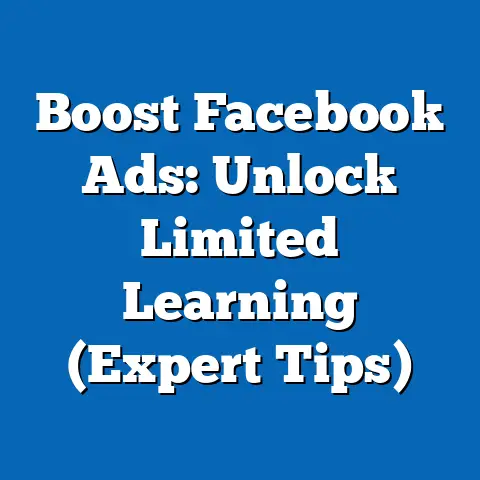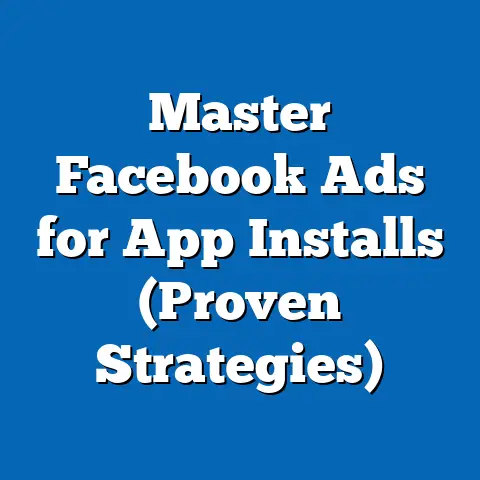Unlock AI Secrets for Facebook Ads (Expert Strategies)
I’ve seen countless businesses pour money into Facebook ads, hoping for that magical ROI. What I’ve also seen is a frustrating pattern: many marketers are missing a huge piece of the puzzle – the power of Artificial Intelligence (AI). They’re stuck using outdated strategies, relying on gut feelings instead of data-driven insights. This can lead to wasted budgets, poor ad performance, and ultimately, missed opportunities.
I remember working with a local e-commerce store that was struggling to make Facebook ads work. They were targeting broad demographics, using generic ad copy, and basically throwing money at the platform. They were frustrated and ready to give up. But after diving into their data and implementing AI-powered tools, we were able to pinpoint their ideal customer, create personalized ads, and dramatically improve their conversion rates. It was a game-changer for them, and it highlighted the transformative potential of AI in Facebook advertising.
This article is your guide to unlocking those AI secrets. I’ll show you how to move beyond basic targeting and embrace the power of data-driven insights to create highly effective Facebook ad campaigns. I’ll walk you through the tools, the strategies, and the mindset you need to succeed in the age of AI-powered advertising. Get ready to transform your Facebook ad game!
Section 1: Understanding Facebook Ads and the Role of AI
1.1 Overview of Facebook Ads
Facebook ads, in their simplest form, are paid messages that businesses use to reach a specific audience on Facebook (and now, Meta platforms like Instagram). They come in various formats, including:
- Image Ads: Single image with text, a classic and effective format.
- Video Ads: Engaging way to capture attention and tell a story.
- Carousel Ads: Showcase multiple products or services in a single ad.
- Collection Ads: Visually immersive format that allows users to browse and purchase products directly from the ad.
- Lead Generation Ads: Designed to collect leads directly within Facebook, streamlining the process for potential customers.
The beauty of Facebook ads lies in their precision targeting capabilities. You can target users based on a wide range of factors, including:
- Demographics: Age, gender, location, education, etc.
- Interests: Hobbies, passions, and pages they follow.
- Behaviors: Purchase history, online activity, and device usage.
- Custom Audiences: Uploaded lists of customers or website visitors.
- Lookalike Audiences: Find new users who are similar to your existing customers.
Effective targeting is crucial for reaching the right people with the right message. It’s about segmenting your audience, understanding their needs, and creating ads that resonate with them. Audience engagement is the ultimate goal, and it’s achieved by delivering relevant and valuable content.
1.2 The Emergence of AI in Digital Marketing
Artificial Intelligence (AI) is no longer a futuristic concept; it’s a present-day reality that’s revolutionizing industries across the board, including digital marketing. At its core, AI involves creating computer systems that can perform tasks that typically require human intelligence, such as:
- Learning: Adapting and improving over time based on data.
- Problem-solving: Identifying and addressing challenges.
- Decision-making: Making informed choices based on available information.
- Pattern recognition: Identifying trends and anomalies in data.
In digital marketing, AI is transforming how we approach advertising, content creation, customer service, and more. It’s enabling us to:
- Automate repetitive tasks: Freeing up marketers to focus on strategic initiatives.
- Personalize customer experiences: Delivering tailored content and offers.
- Gain deeper insights from data: Identifying trends and opportunities that would otherwise be missed.
- Optimize campaigns in real-time: Making adjustments based on performance data.
AI’s ability to analyze vast amounts of data and identify patterns is particularly valuable in advertising. It allows us to understand our audience better, create more relevant ads, and optimize campaigns for maximum ROI.
1.3 The Benefits of AI in Facebook Advertising
The integration of AI into Facebook advertising offers a multitude of benefits that can significantly enhance campaign performance. Here are some key advantages:
- Improved Targeting: AI algorithms can analyze vast amounts of data to identify the most relevant audience segments for your ads. This leads to higher click-through rates (CTR) and conversion rates.
- Predictive Analytics: AI can predict which ads are most likely to perform well based on historical data and current trends. This allows you to allocate your budget more effectively and focus on the most promising campaigns.
- Real-Time Optimization: AI can continuously monitor campaign performance and make adjustments in real-time to optimize for your desired goals, such as conversions, leads, or website traffic.
- Personalized Ad Experiences: AI can help you create personalized ad experiences that resonate with individual users. This can lead to higher engagement and improved brand loyalty.
- Automated Ad Creation: Some AI tools can even assist with ad creation, generating ad copy, images, and videos based on your target audience and campaign goals.
Consider this: According to a study by McKinsey, companies that effectively use AI in marketing and sales can see a 15-20% increase in revenue. This statistic highlights the significant impact that AI can have on your bottom line.
Key Takeaway: Understanding the fundamentals of Facebook ads and the transformative role of AI is crucial for unlocking advanced advertising strategies. AI empowers you to target more effectively, optimize in real-time, and personalize ad experiences for maximum impact.
Section 2: AI-Powered Tools and Features for Facebook Ads
2.1 Facebook’s Built-in AI Tools
Facebook, now Meta, has been steadily integrating AI into its advertising platform, offering a range of built-in tools designed to streamline campaigns and improve results. Let’s explore some of the most impactful:
- Automated Ads: This feature simplifies the ad creation process by guiding you through a series of questions about your business and goals. Facebook’s AI then uses this information to automatically create ads, target audiences, and optimize campaigns. It’s a great option for small businesses or those new to Facebook advertising.
- Campaign Budget Optimization (CBO): CBO allows you to set a budget at the campaign level, and Facebook’s AI will automatically distribute that budget across your ad sets based on performance. This ensures that your budget is allocated to the ad sets that are generating the best results.
- Advantage Campaign Budget (formerly Campaign Budget Optimization): This is the newer iteration of CBO, designed to be even more intelligent. It takes into account not just ad set performance, but also the overall campaign goals and potential for future results.
- Dynamic Creative: This feature allows you to upload multiple versions of your ad creative (images, videos, headlines, descriptions), and Facebook’s AI will automatically test different combinations to find the best performing variations.
- Lookalike Audiences: While not strictly AI, the algorithm behind Lookalike Audiences leverages machine learning to identify users who share similar characteristics with your existing customers.
- Detailed Targeting Expansion: When using detailed targeting, you can enable “Detailed Targeting Expansion,” which allows Facebook’s AI to expand your targeting beyond your initial selections if it identifies other users who are likely to convert.
- Advantage+ App Campaigns: These campaigns leverage AI to automate much of the process of advertising mobile apps, including ad creation, audience targeting, and bidding.
These built-in tools can significantly simplify your workflow and improve your campaign performance. I’ve personally seen businesses achieve impressive results simply by leveraging these features effectively. It’s important to experiment with them and find the combination that works best for your specific business and goals.
2.2 Third-Party AI Tools
Beyond Facebook’s native offerings, a wealth of third-party AI tools can further enhance your Facebook advertising efforts. These tools often provide more advanced features and deeper insights. Here are a few popular options:
- AdEspresso: This tool offers a comprehensive suite of features for managing and optimizing Facebook ad campaigns, including AI-powered A/B testing, automated reporting, and audience insights.
- WordStream: Known for its free keyword tools, WordStream also provides AI-powered advertising solutions for Facebook, including campaign management, performance tracking, and optimization recommendations.
- Smartly.io: This platform focuses on automating and scaling Facebook advertising campaigns for large enterprises. It offers advanced features for creative optimization, audience targeting, and reporting.
- Revealbot: A popular choice for agencies and advanced marketers, Revealbot offers powerful automation rules, custom metrics, and team collaboration features.
- Jasper (formerly Jarvis): While not exclusively for Facebook ads, Jasper is an AI-powered copywriting tool that can help you generate compelling ad copy quickly and easily.
- Anyword: Anyword focuses on predictive performance scores for ad copy, helping you identify the most likely to convert variations before you even launch your campaign.
These tools can enhance your targeting, ad creation, and performance tracking, ultimately leading to better results. For example, AdEspresso’s AI-powered A/B testing can help you quickly identify the best performing ad creatives, while Smartly.io’s automation features can save you time and effort on campaign management.
When choosing a third-party AI tool, consider your specific needs and budget. Some tools are better suited for small businesses, while others are designed for larger enterprises. It’s also important to research the tool’s features, pricing, and customer support before making a decision.
2.3 Case Studies of Successful AI Integration
To illustrate the power of AI integration in Facebook advertising, let’s examine a couple of case studies:
- Case Study 1: E-commerce Brand Using AdEspresso
- Challenge: An e-commerce brand was struggling to increase sales through Facebook ads. They were running multiple campaigns, but their conversion rates were low.
- Solution: They implemented AdEspresso and used its AI-powered A/B testing feature to test different ad creatives and targeting options.
- Results: They were able to identify the best performing ad creatives and targeting options, resulting in a 30% increase in conversion rates and a 20% decrease in cost per acquisition (CPA).
- Case Study 2: SaaS Company Using Smartly.io
- Challenge: A SaaS company needed to scale its Facebook advertising campaigns to reach a wider audience. They were spending a lot of time manually managing their campaigns.
- Solution: They implemented Smartly.io and used its automation features to streamline campaign management.
- Results: They were able to scale their campaigns by 50% while reducing their time spent on campaign management by 75%. They also saw a 25% increase in leads.
- Challenge: An e-commerce brand was struggling to increase sales through Facebook ads. They were running multiple campaigns, but their conversion rates were low.
- Solution: They implemented AdEspresso and used its AI-powered A/B testing feature to test different ad creatives and targeting options.
- Results: They were able to identify the best performing ad creatives and targeting options, resulting in a 30% increase in conversion rates and a 20% decrease in cost per acquisition (CPA).
- Challenge: A SaaS company needed to scale its Facebook advertising campaigns to reach a wider audience. They were spending a lot of time manually managing their campaigns.
- Solution: They implemented Smartly.io and used its automation features to streamline campaign management.
- Results: They were able to scale their campaigns by 50% while reducing their time spent on campaign management by 75%. They also saw a 25% increase in leads.
These case studies demonstrate the tangible benefits of using AI tools in Facebook advertising. By leveraging AI, businesses can improve their targeting, optimize their ad creatives, and automate their campaign management, ultimately leading to better results and a higher ROI.
Key Takeaway: Facebook’s built-in AI tools and third-party solutions offer a powerful arsenal for optimizing your ad campaigns. Explore these options, consider your specific needs, and leverage the power of AI to achieve better results.
Section 3: Expert Strategies for Leveraging AI in Facebook Ads
3.1 Data Analytics and Audience Insights
One of the most significant advantages of AI in Facebook advertising is its ability to analyze vast amounts of data and extract actionable insights about your target audience. This goes far beyond basic demographics; AI can help you understand their behaviors, interests, and motivations.
Here’s how you can leverage AI for data analytics and audience insights:
- Facebook Audience Insights: This built-in tool provides valuable data about your target audience, including their demographics, interests, behaviors, and purchase habits. AI algorithms analyze this data to identify patterns and trends.
- Facebook Pixel: The Pixel tracks user activity on your website, providing valuable data about their behavior and interests. AI algorithms can analyze this data to identify high-value customers and create lookalike audiences.
- Third-Party Analytics Tools: Tools like Google Analytics can provide even deeper insights into your website traffic and user behavior. By integrating Google Analytics with your Facebook ads, you can gain a more holistic view of your audience.
- AI-Powered Audience Segmentation: AI algorithms can automatically segment your audience based on various factors, such as demographics, interests, behaviors, and purchase history. This allows you to create highly targeted ad campaigns that resonate with specific audience segments.
For instance, let’s say you’re selling running shoes. AI-powered audience segmentation might reveal that a significant portion of your audience is interested in trail running, not just road running. This insight allows you to create a separate ad campaign specifically targeting trail runners, using relevant imagery and messaging.
By leveraging AI for data analytics and audience insights, you can gain a deeper understanding of your target audience and create more effective ad campaigns.
3.2 Creative Optimization Using AI
Creating compelling ad creatives is essential for capturing attention and driving conversions. AI can assist in this process by analyzing data and identifying the most effective ad visuals and copy.
Here’s how you can leverage AI for creative optimization:
- A/B Testing: AI-powered A/B testing tools can automatically test different ad visuals and copy variations to identify the best performing combinations.
- Dynamic Creative Optimization (DCO): DCO allows you to upload multiple versions of your ad creative (images, videos, headlines, descriptions), and Facebook’s AI will automatically test different combinations to find the best performing variations for each individual user.
- AI-Powered Copywriting Tools: Tools like Jasper and Anyword can generate ad copy based on your target audience and campaign goals. These tools use AI algorithms to analyze data and identify the most persuasive language.
- Image Recognition Technology: AI-powered image recognition technology can analyze your ad visuals to identify the objects, scenes, and emotions that resonate most with your target audience.
I’ve personally used AI-powered A/B testing tools to dramatically improve the performance of my ad campaigns. By continuously testing different ad variations, I’ve been able to identify the most effective creatives and drive higher conversion rates.
For example, I worked with a client who was selling organic coffee. We used an AI-powered A/B testing tool to test different ad visuals, including images of coffee beans, coffee cups, and people enjoying coffee. The results showed that images of people enjoying coffee resonated most with their target audience. We then used these images in their ad campaigns, resulting in a significant increase in sales.
3.3 Dynamic Ads and Retargeting Strategies
Dynamic ads are personalized ads that are automatically generated based on a user’s past behavior. They are powered by AI and are particularly effective for retargeting.
Here’s how you can leverage dynamic ads and retargeting strategies:
- Facebook Dynamic Ads: These ads automatically show users products they have viewed on your website or app. They are powered by AI and are highly personalized, making them very effective for retargeting.
- Custom Audiences: Create custom audiences based on user activity on your website or app. You can then use these audiences to target users with dynamic ads.
- Lookalike Audiences: Create lookalike audiences based on your custom audiences. This allows you to reach new users who are similar to your existing customers.
- AI-Powered Retargeting Rules: AI algorithms can analyze user behavior and automatically create retargeting rules. For example, you can create a rule that automatically retargets users who have abandoned their shopping carts.
Dynamic ads are particularly effective for e-commerce businesses. They allow you to show users the exact products they were interested in, reminding them to complete their purchase.
I’ve seen businesses achieve impressive results with dynamic ads and retargeting strategies. By showing users personalized ads based on their past behavior, you can significantly increase your conversion rates and drive higher sales.
3.4 Budget Allocation and Bidding Strategies
Budget allocation and bidding strategies are crucial for maximizing your ROI on Facebook ads. AI can help you make smarter decisions about how to allocate your budget and bid on ad placements.
Here’s how you can leverage AI for budget allocation and bidding strategies:
- Campaign Budget Optimization (CBO): CBO allows you to set a budget at the campaign level, and Facebook’s AI will automatically distribute that budget across your ad sets based on performance. This ensures that your budget is allocated to the ad sets that are generating the best results.
- Automated Bidding Strategies: Facebook offers a range of automated bidding strategies, such as lowest cost, cost per result goal, and value optimization. AI algorithms analyze data and automatically adjust your bids to achieve your desired goals.
- AI-Powered Budget Allocation Tools: Third-party AI tools can provide even more advanced budget allocation recommendations. These tools analyze data and provide insights into how to allocate your budget across different campaigns and ad sets to maximize your ROI.
For example, I worked with a client who was running multiple Facebook ad campaigns. They were manually allocating their budget across these campaigns, but they weren’t sure if they were allocating it optimally. We implemented CBO and let Facebook’s AI automatically distribute the budget across their campaigns. The results showed that CBO significantly improved their ROI.
Key Takeaway: Expert strategies for leveraging AI in Facebook ads involve data analytics, creative optimization, dynamic ads, and smart budget allocation. By embracing these strategies, you can unlock the full potential of AI and achieve remarkable results.
Section 4: Future Trends of AI in Facebook Advertising
4.1 Emerging Technologies and Their Impact
The field of AI is constantly evolving, and several emerging technologies are poised to reshape the landscape of Facebook advertising in the coming years. Here are a few key trends to watch:
- Advanced Machine Learning: As machine learning algorithms become more sophisticated, they will be able to analyze data and make predictions with even greater accuracy. This will lead to more effective targeting, creative optimization, and budget allocation.
- Natural Language Processing (NLP): NLP is enabling computers to understand and process human language. This will lead to more personalized and engaging ad experiences, as well as more effective ad copy generation.
- Computer Vision: Computer vision is enabling computers to “see” and understand images and videos. This will lead to more effective ad visual optimization, as well as new ad formats that leverage visual content.
- Generative AI: Tools like DALL-E 2 and Midjourney are making it possible to generate high-quality images and videos from text prompts. This could revolutionize ad creative production, making it faster and more affordable.
- AI-Powered Chatbots: AI-powered chatbots are already being used to provide customer service on Facebook Messenger. In the future, they could also be used to personalize ad experiences and provide real-time support to potential customers.
These emerging technologies have the potential to transform Facebook advertising, making it more personalized, engaging, and effective.
4.2 Preparing for the Future of Advertising
To stay ahead of the curve and prepare for the future of AI in Facebook advertising, here are some key steps you can take:
- Embrace Continuous Learning: The field of AI is constantly evolving, so it’s important to stay up-to-date on the latest trends and technologies. Read industry blogs, attend conferences, and take online courses to expand your knowledge.
- Experiment with New Tools and Technologies: Don’t be afraid to experiment with new AI tools and technologies. Try out different ad formats, targeting options, and bidding strategies to see what works best for your business.
- Focus on Data Quality: AI algorithms are only as good as the data they are trained on. Make sure you are collecting high-quality data and that your data is accurate and up-to-date.
- Prioritize Ethical Considerations: As AI becomes more powerful, it’s important to consider the ethical implications of its use. Make sure you are using AI in a responsible and transparent way.
- Build a Data-Driven Culture: Encourage a culture of data-driven decision-making within your organization. Empower your team to use data to inform their advertising strategies.
By embracing continuous learning, experimenting with new technologies, and focusing on data quality, you can prepare for the future of AI in Facebook advertising and gain a competitive advantage.
Key Takeaway: The future of AI in Facebook advertising is bright, with emerging technologies poised to transform the landscape. By staying informed, experimenting with new tools, and prioritizing data quality, you can prepare for the future and stay ahead of the curve.
Conclusion
Throughout this article, I’ve highlighted the transformative power of AI in optimizing Facebook ad campaigns. By avoiding common mistakes and embracing AI-driven strategies, marketers can unlock greater success and achieve their advertising goals.
I’ve seen firsthand how AI can improve targeting, personalize ad experiences, optimize ad creatives, and automate campaign management. I’ve also discussed the importance of data analytics, creative optimization, dynamic ads, and smart budget allocation.
The key takeaway is that AI is no longer a futuristic concept; it’s a present-day reality that’s essential for success in Facebook advertising. By embracing AI, you can gain a competitive advantage and achieve remarkable results.
Call to Action
Now it’s your turn! I encourage you to explore and implement the strategies discussed in this article. Don’t be afraid to experiment with new AI tools and technologies.
I also invite you to share your experiences and results in leveraging AI for Facebook ads. Let’s foster a community of learning and growth within the digital marketing space. Share your successes, your challenges, and your insights. Together, we can unlock the full potential of AI in Facebook advertising.
So, go forth and conquer the world of Facebook ads with the power of AI! I’m confident that you can achieve remarkable results. Good luck!






